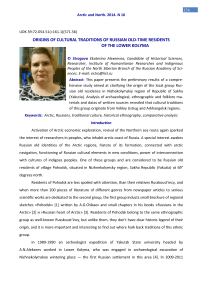Origins of Cultural Traditions of Russian Old‐time Residents of the Lower Kolyma
Автор: Strogova E.A.
Журнал: Arctic and North @arctic-and-north
Рубрика: Historical sciences
Статья в выпуске: 16, 2014 года.
Бесплатный доступ
This paper presents the preliminary results of a comprehensive study aimed at clarifying the origin of the local group Russian old residence in Nizhekolymskiy region of Republic of Sakha (Yakutia). Analysis of archaeological, ethnographic and folklore materials and datas of written sources revealed that cultural traditions of this group originate from Velikiy Ustiug and Arkhangelsk regions.
Arctic, Russians, traditional culture, historical ethnography, comparative analysis
Короткий адрес: https://sciup.org/148319834
IDR: 148319834 | УДК: 39:72-‐054.51(=161.1)(571.56)
Текст научной статьи Origins of Cultural Traditions of Russian Old‐time Residents of the Lower Kolyma
Activation of Arctic economic exploration, revival of the Northern sea route again sparked the interest of researchers in peoples, who inhabit arctic coast of Russia. A special interest awakes Russian old identities of the Arctic regions, history of its formation, connected with arctic navigation, functioning of Russian cultural elements in new conditions, power of interconnection with cultures of indigoes peoples. One of these groups and are considered to be Russian old residents of village Pohodsk, situated in Nizhnekolymsky region, Sakha Republic (Yakutia) at 69° degrees north.
Residents of Pohodsk are less spoiled with attention, than their relatives Russkoust’incy, and when more than 200 pieces of literature of different genres from newspaper articles to serious scientific works are dedicated to the second group, the first group inducts small brochure of regional sketches «Pohodsk» [1] written by A.G.Chikaev and small chapters in his books «Russians in the Arctic» [2] и «Russian heart of Arctic» [3]. Residents of Pohodsk belong to the same ethnographic group as well--‐known Russkoust’incy, but unlike them, they don’t have clear historic legend of their origin, and it is more important and interesting to find out where hark back traditions of this ethnic group.
In 1989--‐1990 an archeologist expedition of Yakutsk State university headed by A.N.Alekseev worked in Lower Kolyma, who was engaged in archaeological excavation of Nizhnekolymskoe wintering place — the first Russian settlement in this area [4]. In 2009--‐2011
excavations were continued by team of archeological expedition of SPA «Northern archeology 1» under the command of G.P.Vizgalov [5, 6, 7]. Collection of ethnographic materials were led by E.A.Strogova in 2005, 2009 and 2011. Collected during some years data of archeological, ethnographic, folk and historic researches let us make us such an attempt.
Russian settlements in Yakutia
First Russian settlements in the noted area appear in the beginning of 40s of the XVIIth
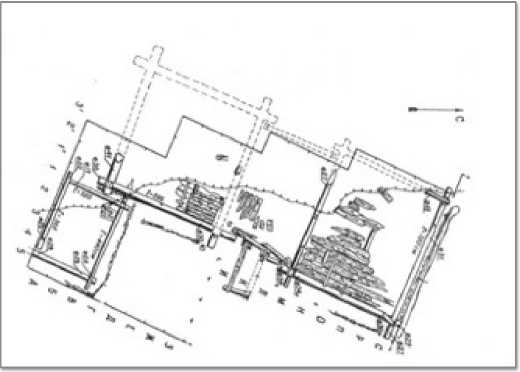
Pic.1. Plan of dwelling house excavation. The Lower Kolyma wintering place. 1989, 2010
century, and by the end of century the whole north of Yakutia is occupied by number of ostrozhka, «yasashniy» and «industrial» wintering places, most of which became extinct by the beginning of the XVIII century. «Numeration of far and near yasachny ostrozhka and wintering places of Yakutsk county governors» founded 16755 shows that there were no Russians on that territory. It is hardly true because some industrial people settled in big («fundamental») wintering places for tens of years. During the second half of XVII --‐ beginning of XVIII centuries in the Lower Kolyma from those settled manufacturers and service class people a group of people began to establish, who considered to be the Kolyma groundlings, but in fact they were engaged with fishing and hunting. By the end of XVIIIth century peasantry was formed here consisted of those groundlings, rewritten into peasantry according to legislation of those times.
In the XVIIth --‐ beginning of the XVIIIth centuries chief role in formation and growth of Russian population in Yakutia played migrants from Russia and Siberia. Specialty of this northern region, in connection with central Yakutia, is considered to be the fact that in the second half of the XVIIIth century the main role in formation of Russian population was given to natural increase, which influence high level of crossbreeding of indigoes Russian peoples.
In such a way by the end of XVIII century a basis for investigated old--‐resident group was formed, who during next hundreds of years saved its entity, when practically not being refilled by new occupants because of extreme remoteness. In 1989--‐90s and in 2009--‐2011 archeological investigations of the Lower Kolyma wintering places, known in literature as Staduhinsky ostrog, built in 1655. In two building horizons dating back to the second half of the XVIIth --‐ first half of the XVIIIth century stocks of housing and household buildings were studied, a unique collection of cultural artifacts was achieved.
A housing building is represented by stocks of a three--‐part house, consisted of chopped «in seam» izba and klet’, connected with seni, gathered in zaplot. Izba was heated by wattle--‐and--‐daub heating stove, and there was probably a fire--‐place in klet’. From outside the building was warmed with strong clay mound of earth, from the northern side terminated with log of wood, and from the eastern side, entering the yard, with horizontal raddle. Covering of a roof during a long period of time was reconstructed based on existed pictures of the Lower Kolyma pit, built 1769 as cockery. This theoretical reconstruction attained its acknowledgement when 2010 during excavation the whole saved batch was founded.
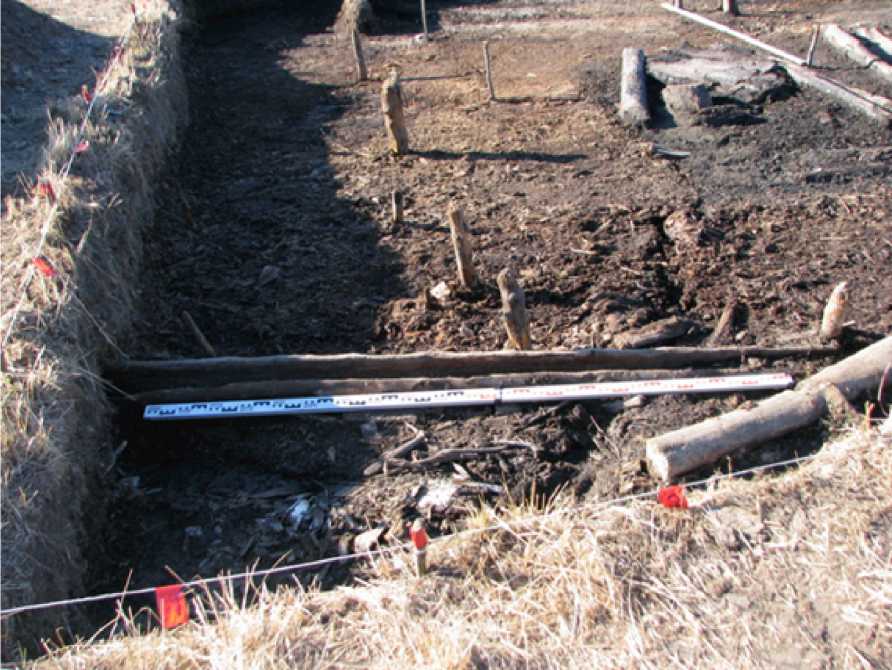
Pic. 2. Flux — one of main details of a building of nailless roof. The Lower Kolyma wintering place. 2011
In klet’ it was probably later made chopped «in seam» household annex, which had mound of earth limited by short raddle. The second household annex stood separately and constituted a filling house made of thin logs of wood with clay mound of earth, limited by the same thin log of wood. Roof with four sloping surfaces was ruined during fire inside the building.
Analysis of construction and design techniques of dwelling and founded architecture details take us to the Russian North, where ternary form of buildings and practice of nailless roof technologies became perhaps symbolic.
Ethnographic material shows wonderful fundamental strength of construction technologies and safety of traditional dwelling design. All the respondent informers remembering house of their childhood told about ternary form of dwelling with characteristic inside design (Pic.3).
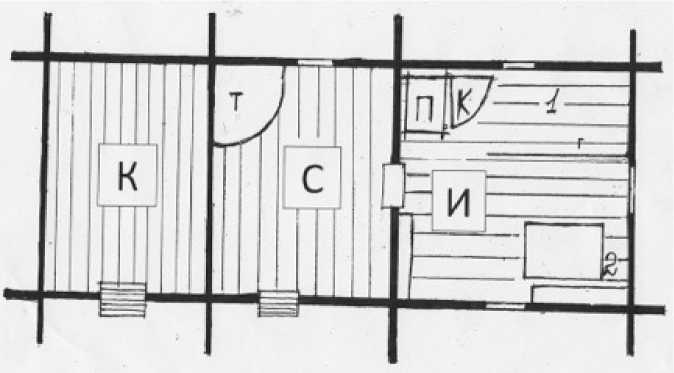
Pic. 3. Traditional dwelling of Kolyma peoples by the pic. of M.P.Olshanceva, 1929. И — izba. С — seny. К — klet’. Т — trivet. П — stove. К — fire--‐place. 1— zagrudka. 2 — red corner.
Saved in tundra of Kolyma hunters lodges, built in XIX --‐ XXth centuries, demonstrate the same technique of construction, as founded during excavation buildings, but with some level of degradation. By later buildings corners of block houses are not structured, there is no cut over in log of wood, but two bean sticks are fixed; by the beginning of the XIXth century high roofs disappeared eventually and they were changed with plain land roof.
But two — «izba--‐seni», and even three--‐part «izba — seni — klet’» design of housing is still appears to be inviolable. It is subject to fishing houses also, which were built by fishing places or in hunting areas. Their construction and design found its complete analogs with houses of manufacturers--‐pomors, founded in Spitsbergen [8, p.411, pic. 2,3].
More exact location of cultural tradition gives search of artifacts analogs. In 2011 during archeological excavations of the Lower Kolyma wintering places in stratiform, dated back to the XVIIth century, a well preserved povoinik was found [7]. Construction of this artifact is interesting because from back along the ochel’e of head--‐dress it was sewed a roller made of tightly stranded red stuff, which above was sewed round the main material of article. It is interesting to know, that even today povoinik is considered to be the chief detail of women in Kolyma traditional costume, but in «cornette», as it is called nowadays, there is no roller. It also showed us degradation of of traditions, as on the Russian North povoinik up to the XIXth century became as individual head--‐ dress, the same as kokoshnik. Alike the founded povoinik with the roller was noted in the book of D.K.Zelyanin. When analyzing traditional women head--‐dresses, author pointed that this povoinik used to be a local tradition of Velikoustuzhskiy uezd of the Vologda county [9]. Another and again women article represents other local tradition.
In materials of the Lower Kolyma wintering place there are two pair of earrings--‐pigeons, made from bronze with settings of jewelry glass. Such earrings--‐pigeons have rase in Velikiy Novgorod and to the beginning of XVIIth century were extremely popular on the whole Russian North. At the picture earrings--‐pigeons are represented from the Lower Kolyma wintering place (to the right) and from the funds of Arkhangelsk museum of fine arts, made from patten brass ( 1).
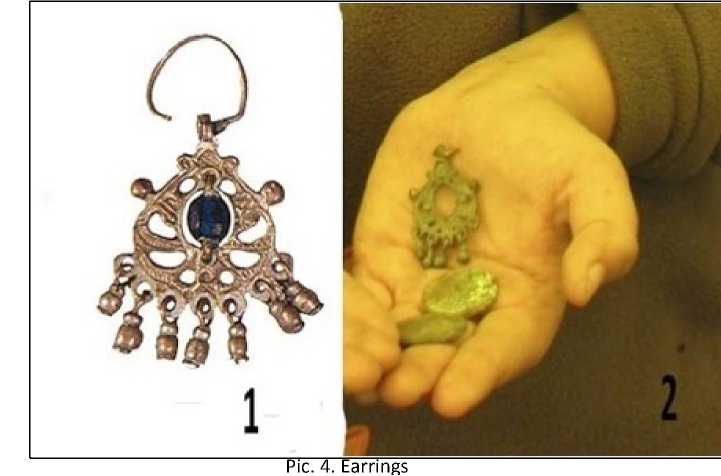
Povoinik and earrings were selected for analysis as the most expressive articles. Other artifacts have either All--‐Russian or All--‐North--‐Russian character and don’t fall for more predict location. Analyzed archeological and ethnographic materials lead us to the Russian North in the regions of Veliky Ustyug and Arkhangelsk.
Interesting results were shown during exploration of folklore. Among rich folklore heritage of old--‐residents of Yakutia arctic regions the most developed by researchers historical song about departure of Skopin--‐Shuisky. Enough number of song about Skopin--‐Shuisky variants let us create historical exploring, find out more ancient and search for parallel guides with other genres.
In the Lower Kolyma this song was registered number of times. Small by volume creation --‐ only 26 poems, with refrain «red--‐green wine» after each line, was registered by Melikov in 1893 [10, p.53]. There are more later records of this song in Kolyma, presented in the book «Russian epic poetry of the Far East Siberia» — [11, №330--‐334], in collected works «Contemporary Russian folklore of Siberia. Novosibirsk» [12, №177--‐205].
A well--‐known researcher of folklore Y.I.Smirnov generally very detailed describes this song, its ritual character and possibility of previous variants [11, p. 433]. As Y.I.Smirnov notes, song «was «sung as «home» wine (in comparison with «nadvorny» which was sung on the street near home)». Later he writes that the text itself «demonstrates sustainable safety» (ibid.). In the lyrics, recorded by E.P.Popov in 1905, Y.I.Smirnov marks another ambivalence of song’s character historical and eulogistic [11, p. 434]. T.S.Shentalskaya when overviewing epic compositions of the Lower Kolyma and Indigirka refers to traditional character of melodious performance of these compositions, «fact of epic song absorption by the sphere of ritual act» [13, p.48 --‐ 53].
On the European part of Russia performance of epic creations as ritual or eulogistic «fact is locally specific, lock to location only in former Velikoustyug uezd (now the Vologda Region; (song of Skopin, «Falcon--‐ship») and in Vyatka («Falcon--‐ship»)» [13 ,p.53].
For studying of migration processes of Russian through the territory of Yakutia in the initial period of its exploration a data base was created, which included identifying information about inhabitants of its territory in 40--‐60s of the XVIIth century. Data were obtained from custom information, which contained data not only of migrants’ belongings and paid by them taxes, but also data of where they arrived from and also often a route of their movement through the territory of the region 6.
Access let us find, among others, those service class men, manufacturers and merchants, who lived in the middle of the XVIIth century on the Lower Kolyma. Analysis of migrants according to the place of arrival gave following result.
Table 1
Distribution of Russian inhabitants of the Lower Kolyma in 40s of the XVIIth century by exit points
In the category «others» we took 5 yakutian service class men and one yakutian manufacturer, who came from river Kokshenga, river Mezen’, men from Surgut, Olonets, Ust’--‐ Cilma, Karelia, Tobolsk, Kaigorod, Pustozer’, Vladimir and Kaluga. Results of exit points are shown in pic.7. It is visible, that marks are grouped in two rather compact groups, first is in the region of Veliky Ustyug, the second in the region of Arkhangelsk.
In such a way, data of archeological, ethnographic and folklore investigations and written sources unexpectedly with one mind send the researcher to the Russian North, in the regions of Arkhangelsk and Veliky Ustyug.
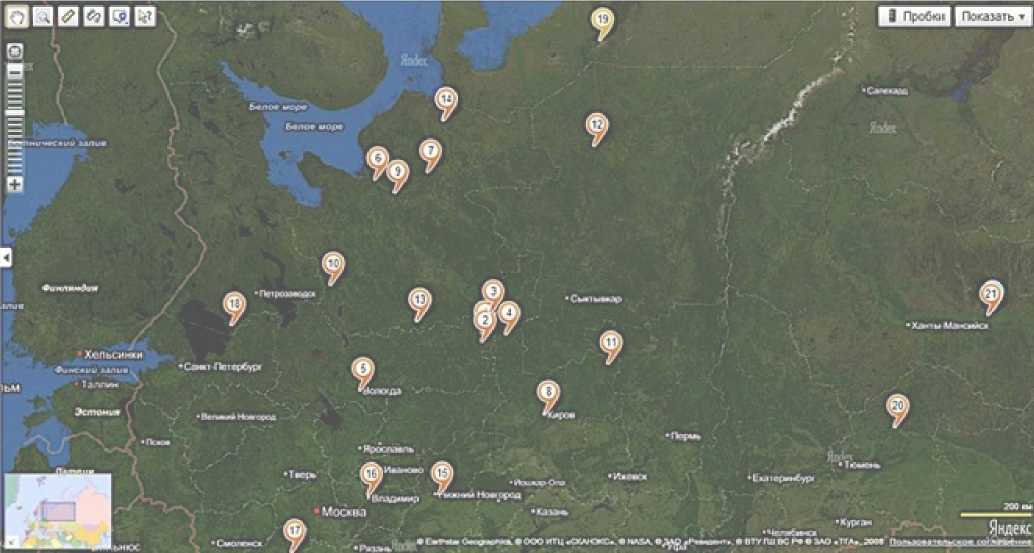
Pic. 5. Exit points of migrants, who live in Low Kolyma in 40s of the XVIIth century. Places, pointed on the map: 1 --‐ Veliky Ustyug. 2 — river Yug. 3 — river Vichegda. 4 — Lalsk. 5 — Vologda. 6 — Arkhangelsk. 7 — river Pinega. 8 — Vyatka. 9 — Cholmogory. 10 — Sysola. 11--‐ Kaigorod. 12 — Ust’--‐Cilma. 13 — Kockshenga. 14 — Mezen. 15 — Nizhny Novgorod. 16 — Vladimir. 17 — Kaluga. 18 — Olonec. 19 --‐ Pustozersk. 20 — Tobolsk. 21 — Surgut.
Problems of cultural unities’ adaptation to new conditions of existence arouse great interest among researchers. But how can we appreciate direction of adaptation processes and the depth of happened changes without knowledge of original cultural tradition? That’s why future fundamental researches as separate items and of the whole cultural tradition could help to transfer the problem of cultural adaptation of Russians in the north of Yakutia from the area of unrelated conversations to the sphere of concrete facts.
Список литературы Origins of Cultural Traditions of Russian Old‐time Residents of the Lower Kolyma
- Chikachev A.G. Pohodsk. Starinnoye russkoe selo na Kolyme [Pohodsk. Ancient Russian settlement on Kolyma]. Irkusts: Papirus, 1993, 64 p.
- Chikachev A.G. Russkie v Arktike [Russians in the Arctic]. Novosibirsk: Nauka, 2007, 303 p.
- Chikachev A.G. Russkoye cerdce Arktiki [Russian heart of the Arctic]. Yakutsk: Lit. Fond, 2010, 496 p.
- Alekseev A.N. Perviye Russkiye poseleniya na Severo-vostoke Azii [First Russian settlements on the North-‐West of Asia]. Novosibirsk, Nauka publ., 1996, 152 p.
- Vizgalov G.P. Arheologicheskiye issledovaniya Stadukhinskogo poseleniya (Nizhnekolymskogo ostroga) v Nizhnekolymskom rajone Respubliki Sakha (Yakutia) v 2009 godu [Archeological researches of Stadukhin settlement (Nizhnekolymsk prison) in the Republic Sakha (Yakutia) Nizhnekolymsk region in 2009]. Nefteyugansk, 2010, manuscript, 133 p.
- Vizgalov G.P. Arheologicheskiye issledovaniya Stadukhinskogo poseleniya (Nizhnekolymskogo ostroga) v Nizhnekolymskom rajone Respubliki Sakha (Yakutia) v 2010 godu [Archeological researches of Stadukhin settlement (Nizhnekolymsk prison) in the Republic Sakha (Yakutia) Nizhnekolymsk region in 2010]. Nefteyugansk, 2011, manuscript, 352 p.
- Vizgalov G.P. Arheologicheskiye issledovaniya Stadukhinskogo poseleniya (Nizhnekolymskogo ostroga) v Nizhnekolymskom rajone Respubliki Sakha (Yakutia) v 2011 godu [Archeological researches of Stadukhin settlement (Nizhnekolymsk prison) in the Republic Sakha (Yakutia) Nizhnekolymsk region in 2011]. Nefteyugansk, 2012, manuscript, 360 p. Hohorovsky Y. Pravoslavniye natel’niye kresty iz pomorskih zahoroneniy Yuzhnogo Shpitzbergena [Orthodox next-to-skin crosses from Pomor graves of the South Spitsbergen]. Kul’tura Russkih v arheologicheskih issledovaniyah: mezhdisciplinarniye melody i tehnologii. Sb. nauch. statey [Culture of Russians in archeological researches: cross-disciplinary methods and technologies. Coll.of scientific articles]. Omsk, Omsk RGTU institute (branch) publ., 2011 (in Russian).
- Zelenyn D.K. Zhenskiye golovniye ubory vostochnyh (russkih) slavyan [Women headwear of eastern (Russian) slavic people]. Praga, Slavia publ., year, V, vol. 2 (1926), vol. 3 (1927).
- Charina O.I. Pesny, sobranniye D.I. Melikovym [Songs, collected by D.I. Melikov]. Yakutian archive, 2011, no. 1, pp. 52-‐55.
- Russkaya epicheskaya poeziya Sibiri i Dal’nego Vostoka [Russian epic poetry of Siberia and Far East], Novosibirsk, Nauka publ., 1991, 499 p.
- Kuz’mina L.P., Mironova E.A. Sovremenniy russkiy fol’klor na Krainem Severe [Modern Russian folklore in the Far North]. Sovremenniy russkiy fol’klor Sibiri [Modern Russian folklore in Siberia]. Novosibirsk, 1979, pp. 177-‐205 (in Russian).
- Shental’skaya T.S. Napevy russkih epicheskih pesen Sibiri i Dal’nego Vostoka [Melodies of Russian epic songs of Siberia and Far East]. Russkaya epicheskaya poesiya Sibiri i Dal’nego Vostoka [Russian epic poetry of Siberia and Far East]. Novosibirsk, Nauka publ., 1991 (in Russian).

